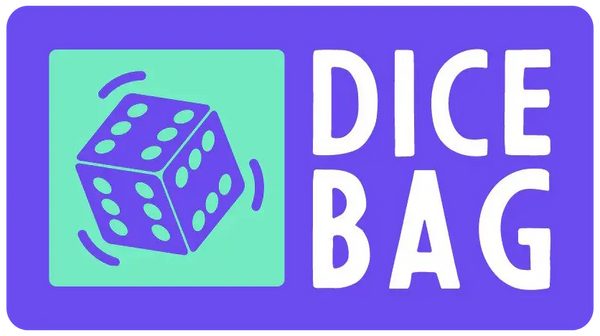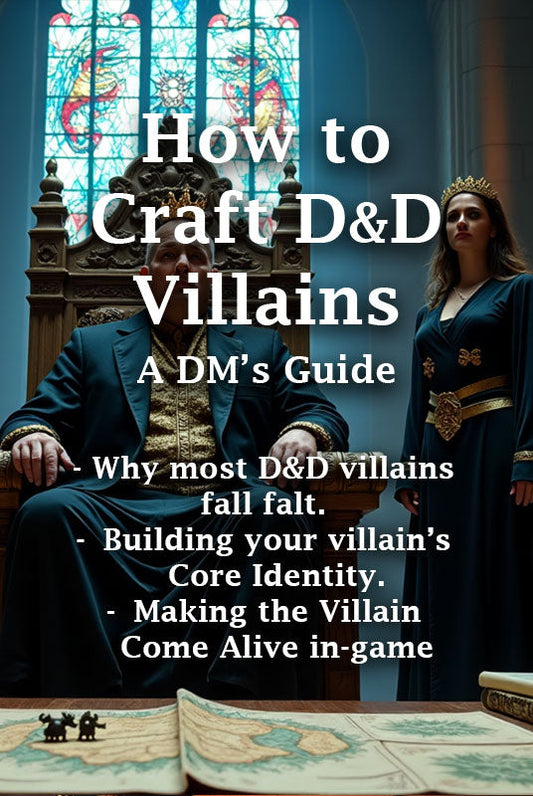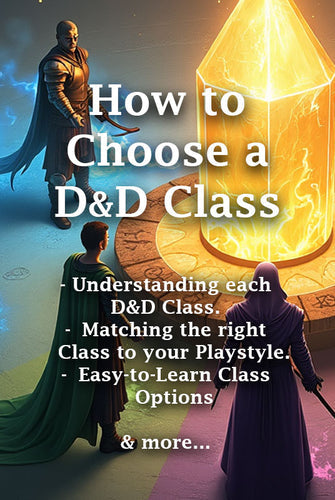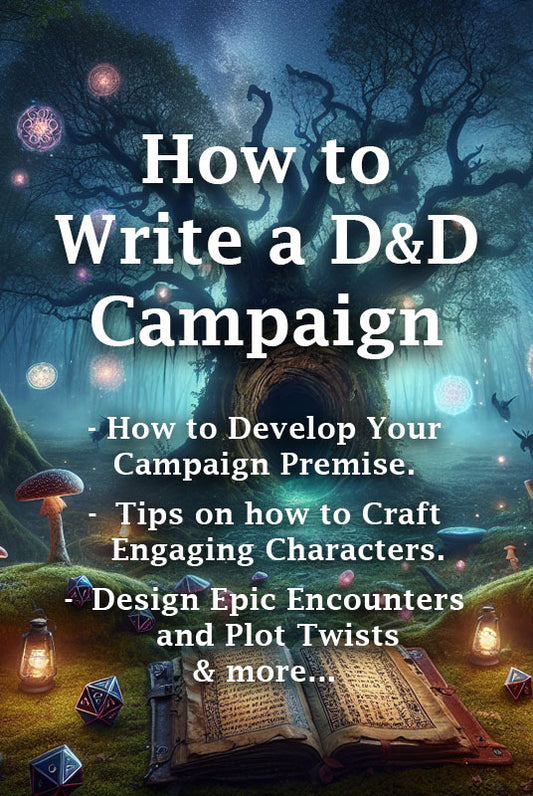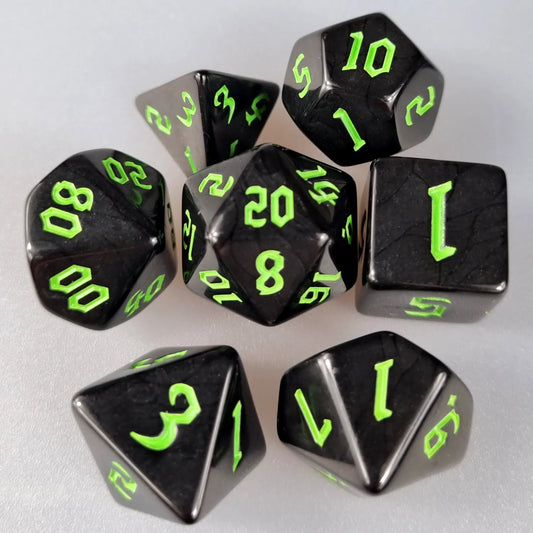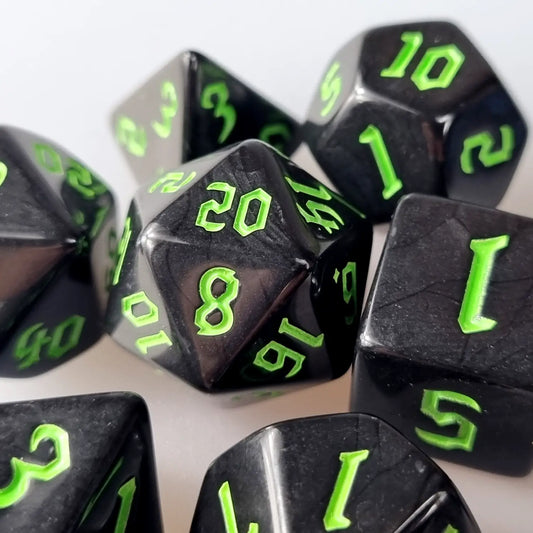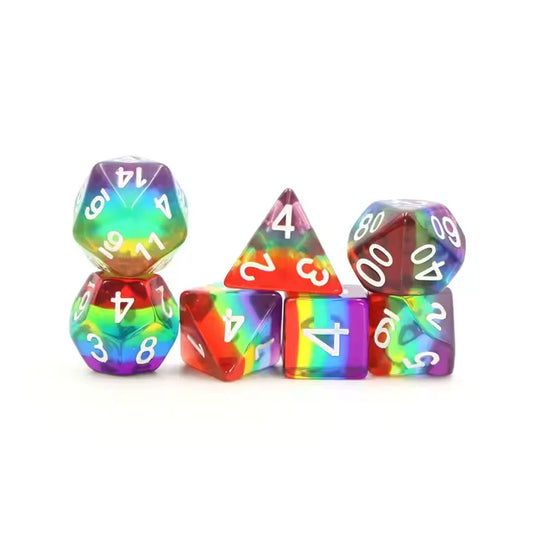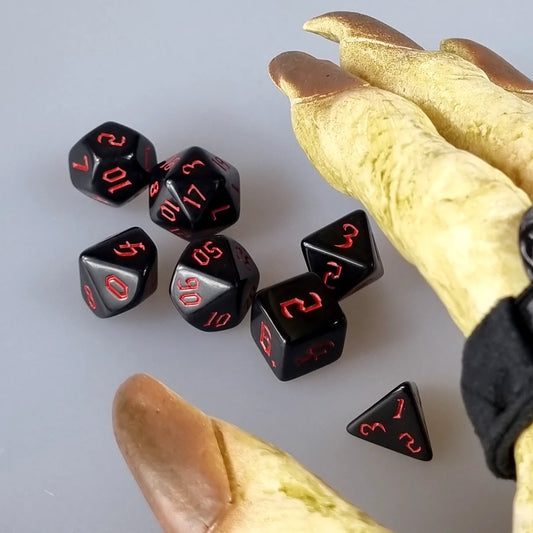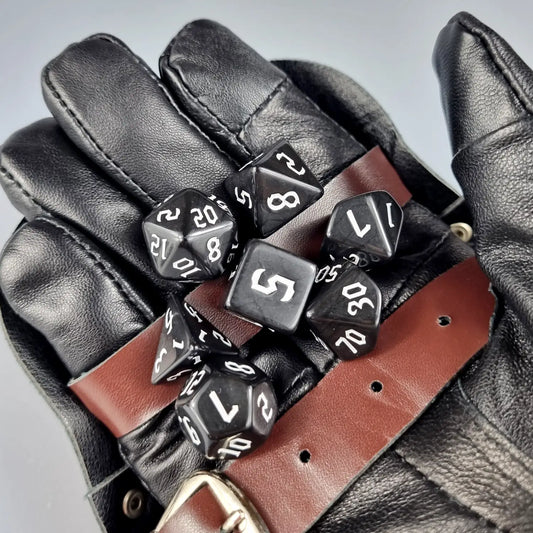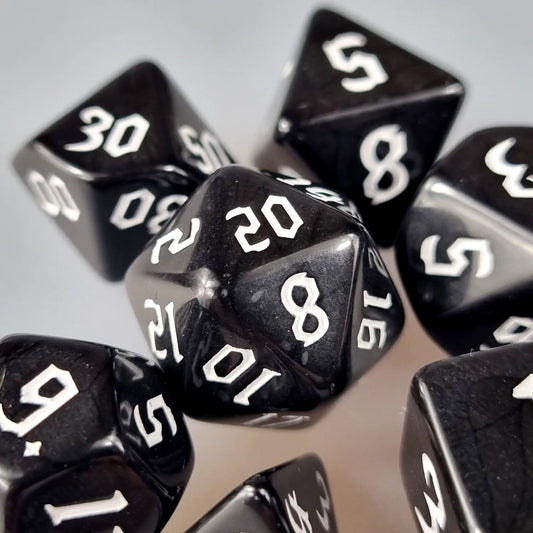
As a Dungeon Master, learning how to write a D&D campaign is an exciting challenge that can lead to memorable evenings of awesome adventures. We all want to create immersive experiences that captivate our players and keep them coming back for more. That's why it's crucial to master the art of crafting engaging storylines that blend action, adventure, and emotional journeys into a cohesive narrative.
In this guide, we'll explore the key elements of writing a compelling D&D campaign. We'll dive into developing a strong premise, creating memorable characters, and designing epic encounters that surprise and delight your players. We'll also look at building a flexible story structure that allows for player worldbuilding while maintaining consistency in your setting. By the end, you'll have the tools to create a campaign with clear conflicts, satisfying conclusions, and plenty of twists along the way.
Develop Your Campaign Premise
To create an engaging D&D campaign, we need to start by developing a solid premise. This is the foundation upon which our entire adventure will be built. Let's explore the key elements that will help us craft a compelling campaign premise.
Define the Setting
This is more than just a map or a world; it's the canvas where our adventures will unfold. When creating our setting, it's crucial to start small and expand as we go. We don't need to plan out every far corner of the world right away. Instead, let's focus on a small area, perhaps a town and its immediate surroundings.
To bring our setting to life, we should consider the following:
- The overall theme or genre (high fantasy, dark fantasy, steampunk, etc.)
- The general terrain types (woods, mountains, grasslands, etc.)
- A few interesting landmarks
- A small town with a handful of non-player characters (NPCs)
- Some nearby adventure sites (a deserted mine, a ruined tower, etc.)
Remember, we can always expand our setting as the campaign progresses. The key is to create a playground for our players' first few adventures.
Establish the Central Conflict
The central conflict is the heart of our campaign. It provides themes to structure our adventure around and gives motivation for our villains. A good conflict creates tension and uncertainty, driving the story forward and keeping our players engaged.
When establishing our central conflict, we should consider:
- The opposing motivations of different factions or characters
- How these motivations are incompatible
- The potential consequences if the conflict remains unresolved
The central conflict doesn't have to be a simple good versus evil scenario. It could be a clash of ideologies, a struggle for resources, or a race against time to prevent a catastrophe. The more nuanced and morally ambiguous our conflict is, the more opportunities we create for interesting character development and player decision-making.
Create Compelling Villains
No D&D campaign is complete without a memorable villain. Our Big Bad Evil Guy should be more than just a moustache-twirling antagonist. They should be a complex character with their own motivations, goals, and backstory.
To create a compelling villain, consider these points:
- Give them a clear goal and motivation
- Make them a foil to the heroes or the world itself
- Ensure they have the means and drive to enact their plans
- Develop their backstory to add depth and complexity
- Allow them to evolve and adapt based on the players' actions
Remember, the villain should believe they are the hero of their own story. Their actions, while potentially harmful or misguided, should make sense from their perspective. This complexity will make our villain more engaging and memorable for our players.
Craft Engaging Characters
Crafting engaging characters is crucial to create an immersive experience in your D&D campaign. We'll explore how to develop player characters, non-player characters (NPCs), and antagonists that will captivate your players and bring your story to life.
Player Characters
Player characters develop at the behest of the Player themselves. As a DM you can help your players develop their characters. This is especially useful if it's their first campaign.
To develop a character further, prompt your players to take some time after each session to reflect on the character's actions and decisions. Get them to ask themselves questions like:
- How does the character feel about what just happened?
- Did any of their actions have consequences?
- What do they want most right now?
These reflections will help players discover more about their character and their motivations. Remember, strong motivations are key to creating interesting characters. A simple formula for motivation is: "I want to [verb] a [noun]." For example, "I want to kill the dragon that torched my village" or "I want to discover the truth about my parentage."
As you play, allow the characters to evolve naturally. Their experiences and interactions with other characters will shape their personality and goals. Let the players know that they should not be afraid to make changes or add new details to your character in relation to the campaign as it progresses.
Non-Player Characters (NPCs)
NPCs are a powerful tool to bring your D&D campaign to life. They can provide objectives, information, challenges, and emotional experiences for the players. When creating NPCs, consider their purpose in the story. Are they a villain, an ally, or someone who adds verisimilitude to the world?
To make NPCs memorable, exaggerate one or two characteristics while adding a few more subtle traits to make them three-dimensional. Give them clear objectives and obstacles to overcome. This will make them feel more real and relatable to the players.
Remember, NPCs don't need extensive backstories or character sheets. Focus on their function in the story and a few key details that will make them stand out. A secret or two can add depth and intrigue to an NPC, giving players something to discover as they interact with them.
Antagonists
Creating compelling antagonists is crucial to have a clear conflict in your D&D campaign. A well-crafted villain can drive the story forward and provide memorable experiences for your players.
When designing your antagonist, consider their motivations carefully. The best villains often have relatable or understandable goals, even if their methods are questionable. This complexity can create moral dilemmas for the players and make the antagonist more engaging.
Give your villain a backstory that explains their actions and drives their behaviour. This doesn't need to be extensive, but it should provide enough context to make them feel like a fully realised character.
Consider how your antagonist can evolve throughout the campaign. They should be able to adapt to the players' actions, learning from encounters and adjusting their strategies accordingly. This evolution will keep the players on their toes and make the villain feel like a formidable opponent.
By crafting engaging NPCs and antagonists, and encouraging players to develop their own characters we can create a cohesive narrative that will captivate our players and make our D&D campaign truly memorable.
Design Epic Encounters and Plot Twists
Designing epic encounters and plot twists is crucial to create an immersive experience in your D&D campaign. We'll explore how to craft balanced combat encounters, incorporate puzzles and mysteries, and introduce unexpected story developments that will keep your players on the edge of their seats.
Balanced Combat Encounters
When preparing encounters for your campaign, it's essential to strike a balance between challenge and fun. We want to create thrilling battles that test our players' abilities without overwhelming them. To achieve this, consider the following:
- Adjust the number of enemies based on the party's size and level
- Mix up enemy types to create diverse challenges
- Incorporate interesting terrain or environmental hazards
Remember, the goal is to create engaging combat that flows naturally within your cohesive narrative. Don't be afraid to tweak encounters on the fly if they're too easy or difficult. You can adjust monster hit points or add reinforcements to maintain the right level of challenge.
Puzzles and Mysteries
Puzzles and mysteries add depth to your campaign, giving players a chance to flex their problem-solving skills. When designing puzzles, keep these points in mind:
- Ensure the puzzle fits logically within your setting
- Provide multiple ways to solve the puzzle
- Include hints or clues that players can discover through skill checks
A well-crafted puzzle can create a satisfying conclusion to a story arc or serve as a gateway to new adventures. Just be careful not to make puzzles too complex, as this can slow down the game's pace.
Unexpected Story Developments
To keep your campaign fresh and exciting, it's crucial to incorporate unexpected twists and surprises. Here are some ways to introduce these elements:
- Reveal hidden motivations of key NPCs
- Introduce a new threat that changes the course of the story
- Subvert common tropes or expectations
When planning these twists, consider how they'll impact the overall narrative and your players' emotional journey. A good twist should enhance the story without feeling forced or arbitrary.
By mastering the art of designing epic encounters and plot twists, you'll create a D&D campaign that captivates your players and keeps them coming back for more. Remember to balance combat, puzzles, and story developments to craft a well-rounded and immersive experience. With practise and creativity, you'll soon be weaving unforgettable adventures that your players will talk about for years to come.
Build a Flexible Story Structure
When we're learning how to write a D&D campaign, it's crucial to create a flexible story structure that allows for player worldbuilding while maintaining consistency in our setting. We can achieve this by using a three-act structure, which provides a solid framework for our cohesive narrative.
Beginning Hook
The first act of our campaign serves as the setup, introducing the characters and the world they inhabit. This is where we establish the tone and theme of our adventure. We want to create an urgent problem that demands action from our players, pulling them into the story.
To craft an engaging hook, we need to appeal to the players' desire for reward, heroism, and discovery. For example, we might have a mysterious stranger approach the party in a tavern with a cryptic message, or have the characters stumble upon an ancient artefact that hints at untold treasures.
Remember, the hook is for the players, not just their characters. We want to create a situation that insists the characters act, using their special skills to solve a problem that ordinary people can't or won't tackle.
Rising Action
The second act is where the bulk of our campaign takes place. This is the confrontation, where our characters face obstacle after obstacle in their quest to achieve their goal. We want to create a series of encounters that test our players' abilities and push the story forward.
When designing these encounters, it's important to offer multiple paths for achieving goals, each with its own set of challenges, risks, and rewards. This encourages creativity and strategic thinking, as players weigh the potential consequences of each choice.
We should also create moral dilemmas that challenge our players' values and beliefs. These difficult choices can lead to powerful moments of introspection and character development, adding depth to our cohesive narrative.
Climax and Resolution
The third act provides the resolution to our campaign. This is where the characters face their greatest challenges before the story comes to a close. The climax should be the highest point of our story, where the conflict is finally resolved.
When planning the climax, we need to consider both success and failure scenarios. No adventure should guarantee one outcome or the other – it's not an adventure if it's just a narration!
To create a satisfying conclusion, we should ensure that the effects of players' choices extend beyond the immediate situation, shaping the course of the campaign and potentially altering the world around them. This underscores the significance of their decisions and encourages players to think carefully about their actions.
By following this flexible story structure, we can create a D&D campaign that balances player agency with a cohesive narrative, leading to an immersive experience that our players will remember for years to come.
Conclusion
Crafting a D&D campaign is an adventure in itself, blending creativity with structure to create unforgettable experiences. By developing a strong premise, designing engaging characters, and building a flexible story structure, you're setting the stage for epic tales that will captivate your players. The key is to strike a balance between planning and spontaneity, allowing room for player input while maintaining a cohesive narrative.
Remember, the goal is to create a shared story that everyone at the table can enjoy. By focusing on balanced encounters, intriguing puzzles, and unexpected twists, you'll keep your players on their toes and fully immersed in the world you've created together. So grab your dice, unleash your imagination, and get ready to embark on the thrilling journey of Dungeon Mastering. Your players are in for a treat!
FAQs
1. How can I make my D&D campaign more captivating?
To enhance the intrigue of your D&D campaign, consider incorporating several key elements: provide a base of operations for the party, offer access to mounts and vehicles, encourage exploration, develop a compelling villain, introduce a central conflict, delve into the characters' backstories, and start with an engaging hook.
2. What are the essentials for crafting a compelling D&D story?
To craft an engaging D&D story, select a theme and a suitable boss monster or villain. Outline a flexible narrative, define the locations, develop interesting non-player characters (NPCs), and choose obstacles that align with the theme and lead to the boss.
3. How do you develop a plot for a D&D campaign?
Developing a plot for a D&D campaign involves several steps: start with a solid adventure idea, create enticing hooks, outline the adventure as if you were playing it, design an effective map, turn your outline into dungeon master-friendly content, and finally, layout your document and incorporate artwork.
4. What is the best way to outline a D&D campaign?
When outlining a D&D campaign, start by establishing the campaign premise. Begin with a smaller scope, employ the rule of three for plot structure, allow players to contribute to worldbuilding, prepare various encounters, define a clear ending, request feedback for future sessions, and embrace familiar tropes to enhance the narrative.
